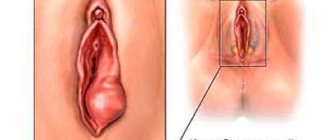The causes of bacterial vaginosis may include:
- taking local contraceptives,
- long-term use of general contraceptives,
- treatment with antibacterial drugs (antibiotics), which, in addition to pathogenic microorganisms, also suppress “beneficial” bacteria in the microflora,
- frequent douching,
- stress,
- intense and prolonged emotional and physical stress,
- disturbances and changes in hormonal levels,
- decreased immunity,
- long-term diets.
Make an appointment
Make an appointment with a urologist by calling 8(812)952-99-95 or filling out the online form - the administrator will contact you to confirm your appointment
guarantees complete confidentiality
Symptoms of gardnerellosis
As a rule, the symptoms of gardnerellosis are quite indicative of this disease - vaginal discharge. The discharge may be clear, white, greyish-white, yellowish or greenish. Most often they are abundant, uniform in consistency, creamy or watery, and often foamy. The labia become red and swollen, a burning and itching sensation appears, and pain may appear in the vaginal and perineal area. The most indicative smell of these secretions is reminiscent of the smell of spoiled (rotten) fish.
Gardnerella in men.
In the male body, gardnerella usually cannot coexist for a long time and is eliminated within a few days after ingestion. But in 10% of cases, mostly asymptomatic, they remain in the urological tissues. In rare cases, long-term carriage is possible. With a decrease in the activity of protective reactions and the development of gardnerellosis in men, men experience: light morning discharge from the urethra and from under the preputial sac, unpleasant odor and itching in the area of the glans penis, discomfort when urinating, burning sensation . In such cases, they talk about nonspecific urethritis or balanoposthitis associated with gardnerella.
A larger number of doctors - urologists and gynecologists, believe that gardnerellosis in men is relatively safe. However, carriage of Gardnerella can cause infection of a sexual partner, so it needs to be treated.
Treatment of gardnerellosis
The principle of treatment is to reduce the number of gardnerella in the vagina, “populate” the vagina with representatives of normal microflora and restore both “local” and general immunity. Self-medication is unacceptable!
The first control laboratory examination is carried out 7-10 days after completion of therapy, repeated after 4-6 weeks.
The doctor looks at how much the clinical picture of the disease has changed, and whether all the symptoms of vaginal dysbiosis have been eliminated with the help of treatment. This also applies to subjective sensations such as pain, burning, discomfort during sexual intercourse, and an objective picture obtained through laboratory tests.
How is Gardnerella transmitted?
To protect yourself from gardnerella, it is important to know where this microorganism comes from.
Can you get this disease from a partner or does it develop on its own?
The bacterium lives only in the urogenital tract.
It is not in the mouth, nor in the rectum, nor in any other parts of the body.
It is called Gardnerella vaginalis precisely because it lives in the female vagina.
In most women they are detected in varying quantities.
For the first time, gardnerella can enter the genitals of men during sex.
Rarely, other routes of infection are possible.
For example, sharing hygiene products with another woman suffering from bacterial vaginosis.
People often ask whether gardnerella is transmitted through oral sex and through kissing (saliva).
This method of infection is impossible.
Because gardnerellas do not live in the mouth.
They are not detected in saliva.
Accordingly, it is impossible to get sick either after oral sex, or even more so after a kiss.
In most women, gardnerella does not cause any symptoms.
Its quantity is very small.
The immune system does not perceive gardnerella as a pathogenic microorganism and does not attack.
Therefore, the inflammatory reaction does not develop even with a large number of these microorganisms.
Normally, 95% of the microflora in a woman’s vagina consists of lactobacilli.
They produce lactic acid.
By maintaining an acidic reaction in the vagina, lactobacilli create unfavorable conditions for other bacteria.
Including for gardnerellas.
But for certain reasons, the number of lactobacilli may decrease.
After this, the production of lysozyme, lactic acid and hydrogen peroxide decreases.
As a result, the pH of the vagina changes to the alkaline side.
The antimicrobial activity of vaginal secretions decreases.
This leads to the fact that other microorganisms begin to actively develop.
One of the main ones is gardnerella.
It is able to quickly displace lactobacilli and replace them.
Why does the primary inhibition of lactobacilli growth and changes in the vaginal biocenosis occur?
There are many reasons for this.
The composition of microflora depends on many external and internal factors, such as:
- hormonal background
- puberty, pregnancy, menopause
- use of various drugs
- surgical operations, etc.
Antibiotics or glucocorticoids can provoke gardnerellosis.
Often, women uncontrollably use antiseptics to wash their genitals.
The risk of an increase in the number of gardnerella in the vagina increases with:
- menstrual irregularities
- sexually transmitted infections, including previously suffered (cured)
- background and precancerous diseases of the cervix
- long-term use of oral contraceptives
- use of an intrauterine device
- insufficient genital hygiene
The number of lactobacilli decreases, and gardnerella has room to grow.
Their population is gradually increasing.
This process occurs slowly, sometimes over years.
Gardnerella produces amino acids and volatile acids.
They break down to amines.
It is these compounds that cause an unpleasant odor from the vagina - the most characteristic symptom of the presence of gardnerella.
Prevention of gardnerellosis
Prevention of gardnerellosis is extremely simple. First of all, it lies in caring for your body.
Since the main reason for the development of gardnerellosis is a decrease in immunity, leading to disturbances in the vaginal microflora, and hormonal disorders, when preventing gardnerellosis one should think about what helps strengthen the immune system. This is a healthy and correct lifestyle - no overwork and stress, healthy eating, enough sleep. It is important to avoid hypothermia, maintain proper genital hygiene, and “reasonable sexual behavior.” Frequent douching for hygiene purposes and the use of contraceptives containing 9-nonoxynol should be avoided.
Closely monitor the presence of vaginal discharge, evaluate its nature and consult a doctor at the first symptoms. Perform regular preventive examinations.
Conditions for development, symptoms and diagnosis of gardnerellosis
Contribute to the appearance of gardnerellosis: frequent douching - washing away the physiological vaginal mucosa - lactobacilli; the use of chlorine-containing antiseptics - Gibitan, Miramistin; contraceptives containing 9-nonoxynol - Nonoxynol or Patentex Oval suppositories; condoms with spermicidal lubricant with 9-nonoxynol; frequent change of partners, multiple sexual contacts; unreasonable or uncontrolled use of antibiotics; decreased immunity, hormonal or metabolic disorders, diseases of the genitourinary organs, radiation exposure, long-term intestinal dysbiosis.
In 50% of cases, gardnerella in women does not cause any symptoms . The other half of women with gardnerellosis are bothered by light, unpleasant-smelling - with the smell of rotten fish, homogeneous, watery, or creamy, grayish discharge from the vagina, covering its walls . may occur , during sexual intercourse and at rest . Complications of bacterial vaginosis are possible: pelvic inflammatory disease, uterine bleeding, infertility, postpartum complications - endometritis.
The diagnosis of gardnerellosis can be made based on complaints, if any, and examination data - the vaginal mucosa is pink, without signs of inflammation, but evenly covered with a smelling, viscous, grayish secretion. After inoculating the smear, Gardnerella is determined by direct immunofluorescence. Microscopy and gynecological smear reveal “key cells.” An amine test and determination of the pH of the secretions are also carried out. The presence of 3 of the listed signs, in any combination, indicates the presence of gardnerellosis.
Gardnerellosis is not classified as an infectious or venereal disease; many deny its sexual transmission. However, its occurrence is directly proportional to the number of sexual contacts and sexual activity.
Therefore, when examining a woman for bacterial vaginosis, additional diagnosis and examination of partners is required to exclude other sexually transmitted infections: trichomonas, mycoplasma, ureaplasma, chlamydia, gonococci, candida, genital herpes, HIV.
Complications and consequences of gardnerellosis
Gardnerellosis, for all its apparent harmlessness, requires treatment. Without proper treatment, gardnerellosis can lead to such consequences as inflammatory diseases of the pelvic organs - endometritis, adnexitis, and a long-term inflammatory process threatens the development of infertility.
The development of such serious diseases is rarely caused directly by gardnerellosis. usually they are caused by disruption of the normal microflora of the vagina and the introduction of pathogenic bacteria in place of healthy microorganisms; the development of gardnerellosis helps to reduce local immunity and increases the risk of any inflammatory diseases of the genitourinary system.
Identification of the causative agent of Gardnerella vaginalis, during which the genetic material (DNA) of Gardnerella is determined in a sample obtained from the urogenital tract using the real-time polymerase chain reaction (RT-PCR) method.
Synonyms Russian
Causative agent of gardnerella (gardnerella), DNA.
English synonyms
G. vaginalis, Haemophilus vaginalis, Corynebacterium vaginalis, DNA.
Research method
Real-time polymerase chain reaction.
What biomaterial can be used for research?
Urogenital scraping.
General information about the study
Gardnerella vaginalis is a gram-negative, facultative anaerobic bacterium that may be present in small quantities as part of the normal vaginal flora.
Gardnerella is the most common cause of bacterial vaginosis, which often occurs in women of reproductive age and is a manifestation of dysbiosis. Rapid proliferation of Gardnerella leads to the displacement of Lactobacillus spp, which predominate in the vagina. and stimulates the overgrowth of anaerobic bacteria and mycoplasmas. The risk of gardnerellosis increases with the use of intrauterine devices, vaginal douching, promiscuity, chlamydial or gonococcal infections, etc.
When G. vaginalis enters the male body, it is most often suppressed within 2-3 days. Ingod, asymptomatic carriage occurs. It is extremely rare that Gardnerella causes urethritis, prostatitis or epididymitis.
In half of infected women, gardnerellosis is asymptomatic. For others, the main manifestation of the disease is vaginal discharge, usually gray or white, often with a “fishy” odor, which intensifies after unprotected intercourse. Itching and burning in the vagina may be bothersome. Signs of inflammation are usually absent. Gardnerellosis contributes to the development of inflammatory diseases of the pelvic organs, including after abortion. Excessive production of cytokines and prostaglandins by gardnerella and infection of the amniotic fluid and membranes in pregnant women with gardnerella causes inflammation of the membranes, miscarriages in the second trimester of pregnancy, premature birth and low birth weight babies, as well as inflammation of the uterine mucosa.
What is the research used for?
- For the diagnosis of gardnerellosis.
- For differential diagnosis of diseases occurring with similar symptoms (along with other studies).
When is the study scheduled?
- If gardnerellosis is suspected.
- When planning a pregnancy.
- In case of miscarriage or complications during pregnancy and childbirth.
- After antibacterial therapy.
What do the results mean?
Reference values: negative.
Negative result
- Gardnerellosis is unlikely.
Positive result
- The presence of gardnerellosis.
What can influence the result?
- Previous antibacterial therapy.









